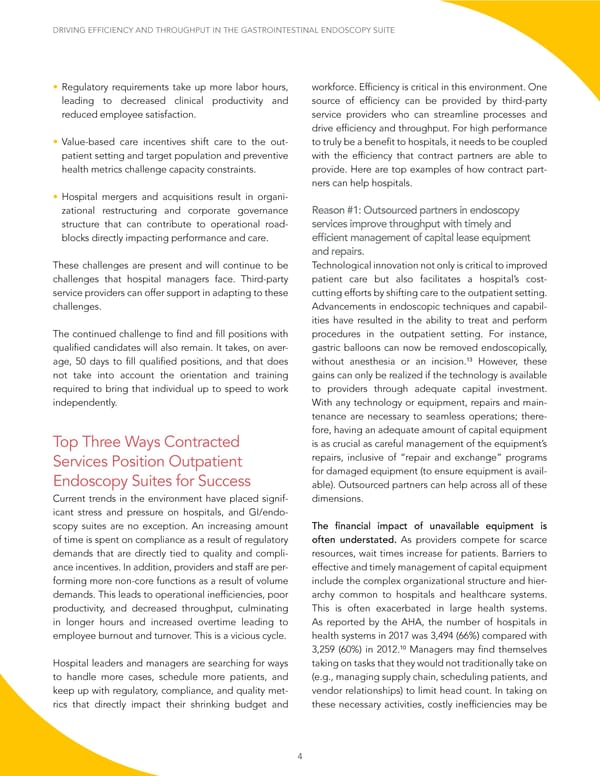DRIVING EFFICIENCY AND THROUGHPUT IN THE GASTROINTESTINAL ENDOSCOPY SUITE • Regulatory requirements take up more labor hours, workforce. Efficiency is critical in this environment. One leading to decreased clinical productivity and source of efficiency can be provided by third-party reduced employee satisfaction. service providers who can streamline processes and drive efficiency and throughput. For high performance • Value-based care incentives shift care to the out- to truly be a benefit to hospitals, it needs to be coupled patient setting and target population and preventive with the efficiency that contract partners are able to health metrics challenge capacity constraints. provide. Here are top examples of how contract part- ners can help hospitals. • Hospital mergers and acquisitions result in org ani- zational restructuring and corporate gov ernance Reason #1: Outsourced partners in endoscopy structure that can contribute to operational road- services improve throughput with timely and blocks directly impacting performance and care. efficient management of capital lease equipment and repairs. These challenges are present and will continue to be Technological innovation not only is critical to improved challenges that hospital managers face. Third-party patient care but also facilitates a hospital’s cost- service providers can offer support in adapting to these cutting efforts by shifting care to the outpatient setting. challenges. Advancements in endoscopic techniques and capabil- ities have resulted in the ability to treat and perform The continued challenge to find and fill positions with procedures in the outpatient setting. For instance, qualified candidates will also remain. It takes, on aver- gastric balloons can now be removed endoscopically, 13 age, 50 days to fill qualified positions, and that does without anesthesia or an incision. However, these not take into account the orientation and training gains can only be realized if the technology is available required to bring that individual up to speed to work to providers through adequate capital investment. independently. With any technology or equipment, repairs and main- tenance are necessary to seamless operations; there- fore, having an adequate amount of capital equipment Top Three Ways Contracted is as crucial as careful management of the equipment’s Services Position Outpatient repairs, inclusive of “repair and exchange” programs Endoscopy Suites for Success for damaged equipment (to ensure equipment is avail- able). Outsourced partners can help across all of these Current trends in the environment have placed signif- dimensions. icant stress and pressure on hospitals, and GI/endo- scopy suites are no exception. An increasing amount The financial impact of unavailable equipment is of time is spent on compliance as a result of regulatory often understated. As providers compete for scarce demands that are directly tied to quality and compli- resources, wait times increase for patients. Barriers to ance incentives. In addition, providers and staff are per- effective and timely management of capital equipment forming more non-core functions as a result of volume include the complex organizational structure and hier- demands. This leads to operational inefficiencies, poor archy common to hospitals and healthcare systems. productivity, and decreased throughput, culminating This is often exacerbated in large health systems. in longer hours and increased overtime leading to As reported by the AHA, the number of hospitals in employee burnout and turnover. This is a vicious cycle. health systems in 2017 was 3,494 (66%) compared with 10 3,259 (60%) in 2012. Managers may find themselves Hospital leaders and managers are searching for ways taking on tasks that they would not traditionally take on to handle more cases, schedule more patients, and (e.g., managing supply chain, scheduling patients, and keep up with regulatory, compliance, and quality met- vendor relationships) to limit head count. In taking on rics that directly impact their shrinking budget and these necessary activities, costly inefficiencies may be 4
 Driving Efficiency & Throughput Page 4 Page 6
Driving Efficiency & Throughput Page 4 Page 6